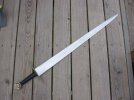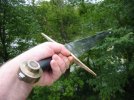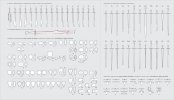- Joined
- Jun 7, 2002
- Messages
- 3,409
Right now i'm curious with the katzbalger design (16th c.) It has a real cutting edge in nearly all versions I've handled, up to the tip. It's a fullered blade so it's light and fast. The only negative to it is it's not much of the stabber due to the blade design. The makers seem to prefer a cutting tool all the way to the tip and as a result the blade it still wide and thick. Also, the s-guard could use a steel plate filler to defend against thrusts to the hand.

What arming sword can give you the best of both worlds (cutting and stabbing)? Better yet if it's even lighter than the katz.

What arming sword can give you the best of both worlds (cutting and stabbing)? Better yet if it's even lighter than the katz.




